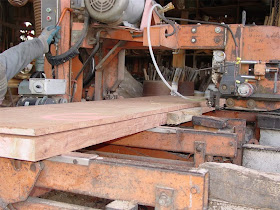When I got to my destination, the weather certainly hadn't warmed up any - the company, as the name suggests, is located in the Berkshire mountains, and there was a dusting of snow on the ground and with a wind blowing it was truly bone-chillin':

After untying the load, and with a little help to carry the board, which must be around 130 lbs, the slab was sitting on the deck of the WoodMizer:

Berkshire Products specializes in a lot of flitch-run slab material, and I was a little surprised that their sawmill was a little dinky thing:

The wider slabs they handle with an 8' long Alaskan mill, with Stihl 066 heads on each end of the bar. Anyway, the sawyer was a nice fellow and obviously conscientious, which eased my apprehension some. I expected the saw blade would probably wander a little bit, but I had enough thickness in the rough stock to obtain what I needed. When in doubt, leave a little more material - that much I knew.
He put a new blade on the machine, and after we fiddled setting the board on the deck just right, he took a slight cut into the end so we could confirm the cut depth:

As it turned out, the blade needed to drop a slight amount from the first mark, and after that it was off to the 'races':

I use the term 'races' a little facetiously, since the cut rate in this case was very slow. Dry bubinga is hard material, and unlike when green lumber is sawn, no water is used to cool/de-gum the blade as it cuts. So, slow and steady were the order of the day. I kept an eye on the far side of the cut, which the sawyer couldn't readily see, in case the blade wanted to dive down anywhere. It went pretty straight for the most part.
A little further in and you can see the slice of wood lifting slightly at the corner:

I kept a close eye on this. Although my initial re-sawing of the material had suggested that it was not subject to much in the way of growth or drying stresses, you never know what might happen when taking a 20.5" wide rip out of a board. My worst fear was the re-saw slice curling up like a potato chip.
More than half way through now, and though the board still has a slight lift, it is not of any concern to me:

Another 10 minutes or so late, and the 1st pass was complete:

Some nice looking material!:

Then the sawyer changed out for a fresh blade, while I went inside the company's main building to get out of the icy temperatures and cold wind. Of course, there was lumber to look at too! Berkshire Products has several large storage buildings on the property, each stuffed to the rafters with huge wide slabs of all sorts of wood. A dangerous place for a wood addict to visit, let me tell you. I have learned to stay clear of those storage buildings to keep the drooling and wallet-emptying tendencies to a minimum.
Fifteen minutes later, it was time for that test cut:

Another slight depth adjustment was made, and then on with the re-sawing:

At the above point in the cut the sawyer stops the mill and slightly re-tensions the blade.
Now we're getting there:

Soon after, the re-sawing was done and both the slices were cleanly cut and pretty straight. Whew! The sawyer mentioned that they had a large SCMI sander-thicknesser in the main building which could flatten out and dimension the material, so I availed myself of that opportunity. That took about another 40 minutes or so, and in the end I had my two table top panels, dressed to 17/32" thick, or 0.53125". That last 0.03125" will be removed by planing and scraping to get to the target dimension of 0.5". I just saved myself some work, though it did cost a few more dollars of course.
Here we are loaded up and ready for the return trip:

The rope is cranked down, bowing the boards a little bit. No way I was going to have any material ejecting on the highway!
The return trip was un-eventful, and nice and warm too! The boards are now back in the shop awaiting the next move. Another step along the path, again without a hitch. I am relieved and pleased, and looking forward to the jointing and planing that will be coming down the pike in another day or so.
Thanks for swinging by today on your journey. --> On to post 9
I can only imagine the the stress of cutting the timber and hoping all will go well.
ReplyDeleteJob well done by all!
Sinjin
Thanks Sinjin, yes a little stressful for sure, though all my past experience with bubinga (far from extensive) led me to anticipate that it would not warp or twist out of the cut. So far so good, and I was thankful to the people at Berkshire Products for their help and careful work.
ReplyDelete~Chris